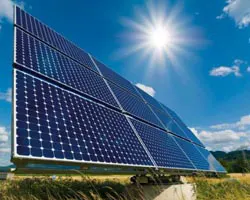Collecting Solar Power More Effectively
Collecting Solar Power More Effectively from the Sun
![]() Most photovoltaic solar panels today only capture a fraction of the available sunlight hitting their surface. Significantly limiting their efficiency and wasting a lot of energy in the process. Then finding ways of collecting solar power more effectively is crucial for improving overall system performance, and thanks to a new material developed by the California Institute of Technology (Caltech), solar panels in the future will finally be able to harness more of the sun’s free power.
Most photovoltaic solar panels today only capture a fraction of the available sunlight hitting their surface. Significantly limiting their efficiency and wasting a lot of energy in the process. Then finding ways of collecting solar power more effectively is crucial for improving overall system performance, and thanks to a new material developed by the California Institute of Technology (Caltech), solar panels in the future will finally be able to harness more of the sun’s free power.
Current Limitations in Solar Technology
Conventional photovoltaic solar systems operate on a simple principle: when sunlight strikes the silicon atoms in a solar panel, the electrons absorb the short wavelengths of solar radiation. These energised particles then move wildly throughout the panel, generating electricity in the form of solar power. However, this design has a fundamental limitation in that these panels only absorb shorter wavelengths of light while longer wavelengths pass through the silicon completely unused.

“The silicon semiconductor material absorbs only a certain fraction of the spectrum, and is transparent to the rest,” explains Harry Atwater, one of the researchers behind the new material being developed.
If I put a photovoltaic module on my roof, the silicon absorbs that portion of the spectrum, and some of that light gets converted into power. But the rest of it ends up just heating up my roof.
Caltech’s Revolutionary New Material
This inefficiency and wasted energy may soon be resolved thanks to the work going on at Caltech (California Institute of Technology) using innovative materials designed specifically to capture and soak-up more of the longer wavelengths from the sun. The researchers their have developed solar panels with a metal-based material infused with electrons that can respond to these longer wavelengths, activating the material’s framework when exposed to parts of the spectrum that traditional panels ignore.
“Normally in a metal like silver or copper or even gold, the density of electrons in that metal is fixed, it’s just a natural property of the material being used” said Atwater. But in the lab, I can add electrons to the atoms of metal nanostructures and charge them up. And when I do that, the resonance frequency change substantially.
Implications for Renewable Energy Systems
Concentrated Photovoltaics (CPV) are already widely used in renewable energy generation schemes and systems, and Caltech’s breakthrough material promises to significantly enhance CPV capabilities. Researchers are now investigating whether Concentrated Solar Power (CSP) which is a technology supported by engineering firms like Unaoil’s partner Sulzer, can be effectively integrated with CPV systems.
The potential of collecting solar power more effectively by combination of CSP and enhanced CPV technology could dramatically increase electricity generation from solar sources. If successful, this integration could substantially reduce global dependence on fossil fuels by creating more efficient and productive solar energy systems that utilize a much broader spectrum of solar radiation.
Then collecting solar power more effectively represents a critical step towards making solar energy more competitive compared to more conventional energy sources by addressing one of photovoltaics’ most persistent limitations of energy conversion over a broad spectrum of sunlight.










Please Speak up!
We hope this Collecting Solar Power More Effectively Tutorial was useful and informative for you. Are you ready to share your thoughts
and experience with us and many others. Your comments are always welcome, just post them in the section below.
P.S. Don't forget to like, rate, and share this Alternative Energy Tutorials post. Thank you for using our website.